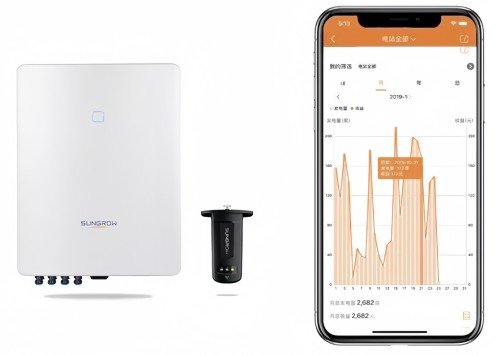
Rooftop solar panels on house
Sungrow and Growatt are two of the most popular brands in the inverter market, offering advanced technologies for both residential and commercial solar systems. While both brands have their strengths, choosing the right one depends on factors like efficiency, warranty, performance in different installations, and value for money. In this article, we’ll compare Sungrow and Growatt inverters across key criteria to help you make the best choice for your solar energy system.
Both Sungrow and Growatt are top contenders, but which one offers the best value, efficiency, and long-term reliability? Let’s find out.
How Do Sungrow and Growatt Inverters Compare in Terms of Efficiency?
Efficiency is a crucial factor in selecting an inverter. A higher efficiency means more of the energy captured by your solar panels is converted into usable electricity, leading to better performance and greater savings.
Let’s compare the efficiency of Sungrow and Growatt inverters to see which offers the better energy conversion.

Growatt inverters on rooftop
Sungrow vs Growatt: Efficiency Comparison
| Inverter Model | Sungrow SG5K-S | Growatt 5000TL-X |
|---|---|---|
| Efficiency | 98.0% | 97.5% |
| Max Output Power | 5kW | 5kW |
| MPPT (Maximum Power Point Tracking) | Dual MPPT | Dual MPPT |
| Operating Temperature Range | -25°C to +60°C | -25°C to +60°C |
| Maximum Input Voltage | 600V | 600V |
-
Efficiency:
- Sungrow: Sungrow inverters offer an efficiency of 98.0%, making them a strong contender in terms of energy conversion. This is suitable for residential and commercial systems where maximizing power output is essential inverter efficiency1.
- Growatt: Growatt inverters offer an efficiency of 97.5%, which is slightly lower than Sungrow’s but still high enough for most applications. While there’s a small difference, Sungrow’s higher efficiency means it will convert slightly more energy into usable power inverter efficiency comparison2.
-
MPPT:
- Both Sungrow and Growatt inverters feature dual MPPT, which allows each solar panel string to operate at its optimal power point. This is particularly useful when panels are subject to shading or are oriented in different directions MPPT technology3.
Conclusion: Sungrow offers slightly higher efficiency at 98.0% compared to Growatt’s 97.5%. This means Sungrow is marginally more efficient, but both brands provide excellent energy conversion.
How Do Sungrow and Growatt Inverters Perform in Different Solar Installations?
The performance of inverters can vary depending on the type of solar installation—whether it’s a small residential setup or a large commercial system. Some inverters may be better suited for certain types of installations based on scalability, ease of installation, and integration with other components.
Let’s compare how Sungrow and Growatt inverters perform in different solar installations.

Solar system connectivity diagram
Sungrow vs Growatt: Performance in Different Installations
-
Residential Systems:
- Sungrow: Sungrow inverters are ideal for residential systems due to their compact design, ease of installation, and high efficiency. Their 98.0% efficiency ensures homeowners get the most out of their solar system.
- Growatt: Growatt inverters are also well-suited for residential applications, with good efficiency and a lower price point. They perform well in small to medium-sized installations, offering good performance at a slightly lower cost residential solar systems4.
-
Commercial Systems:
- Sungrow: Sungrow inverters are highly scalable and suitable for larger commercial systems. Their robust design, higher efficiency, and dual MPPT functionality make them a great choice for complex installations that require high performance commercial solar systems5.
- Growatt: Growatt inverters are increasingly being used in commercial applications due to their efficiency, competitive pricing, and ease of integration with larger systems. While they are not as specialized as Sungrow for very large systems, they still perform well in medium to large commercial setups.
-
Scalability and Integration:
- Sungrow: Sungrow offers excellent scalability, with models that can be easily integrated into both residential and large-scale commercial systems. Their inverters can be paired with energy storage systems for hybrid applications energy storage systems6.
- Growatt: Growatt also offers scalability, though it may be better suited for smaller to medium commercial systems compared to Sungrow’s more robust offerings for larger-scale installations.
Conclusion: Sungrow inverters are better suited for large-scale commercial installations and offer excellent scalability. Growatt inverters are a great choice for residential and medium-sized commercial systems, offering good value for money and ease of integration.
Which Brand Offers Better Value for Money: Sungrow or Growatt?
When selecting an inverter, cost-effectiveness is crucial. The total cost of ownership, including the upfront price, performance, and long-term savings, should be considered. Let’s compare the value for money offered by Sungrow and Growatt inverters.
Let’s evaluate which brand provides better value for money based on cost, performance, and long-term savings.

Sungrow inverter monitoring
Sungrow vs Growatt: Value for Money Comparison
| Inverter Model | Sungrow SG5K-S | Growatt 5000TL-X |
|---|---|---|
| Initial Price | $1,300 – $1,600 | $1,000 – $1,300 |
| Efficiency | 98.0% | 97.5% |
| Payback Period | 5–6 years | 5–6 years |
| Annual Energy Savings | 4,000 – 6,000 kWh | 3,800 – 5,500 kWh |
-
Initial Price:
- Sungrow: Sungrow inverters tend to be priced higher, ranging from $1,300 to $1,600. However, this higher cost is justified by their greater efficiency and suitability for larger installations inverter cost7.
- Growatt: Growatt inverters are more affordable, typically priced between $1,000 and $1,300. This lower upfront cost makes them a more attractive option for residential and smaller commercial systems affordable inverters8.
-
Payback Period:
- Sungrow: Sungrow inverters have a payback period of 5 to 6 years, which is typical for high-efficiency inverters. Despite the higher initial cost, their efficiency can lead to greater energy savings over time solar energy savings9.
- Growatt: Growatt inverters also offer a similar payback period of 5 to 6 years, but with a lower initial investment, they may offer faster returns for those on a budget.
Conclusion: Growatt offers better value for money for those on a budget, especially for residential systems. Sungrow, however, provides better long-term value for those seeking higher efficiency and performance in larger commercial applications.
Conclusion
Both Sungrow and Growatt offer excellent inverters that provide reliable performance, competitive pricing, and strong customer support. Sungrow stands out in terms of higher efficiency, scalability, and suitability for large-scale commercial installations. Growatt, on the other hand, provides a more cost-effective solution for residential and medium-sized commercial systems.
Ultimately, the best choice depends on your system size, budget, and desired performance. If you prioritize efficiency and scalability, Sungrow may be the better option. For those seeking excellent value at a lower cost, Growatt provides a solid solution with good performance.
-
What is inverter efficiency?
Learn how inverter efficiency affects energy conversion and overall system performance. ↩ -
How to compare inverter efficiencies?
Find out how to evaluate efficiency differences between inverter models. ↩ -
What is MPPT technology?
Explore how MPPT ensures maximum power extraction from solar panels under varying conditions. ↩ -
What makes residential solar systems efficient?
Understand the key elements that contribute to the efficiency of residential solar installations. ↩ -
Why are Sungrow inverters preferred for commercial systems?
Explore why Sungrow inverters are ideal for larger, complex commercial systems. ↩ -
What are energy storage systems?
Learn how integrating energy storage with solar inverters enhances performance and scalability. ↩ -
What is the total cost of ownership for inverters?
Learn how the initial cost impacts the long-term savings and payback period for solar inverters. ↩ -
How do affordable inverters compare to high-efficiency models?
Find out how Growatt inverters provide cost-effective solutions for residential and smaller systems. ↩ -
How does the payback period relate to solar inverters' performance?
Understand how the payback period and energy savings are influenced by inverter efficiency. ↩



